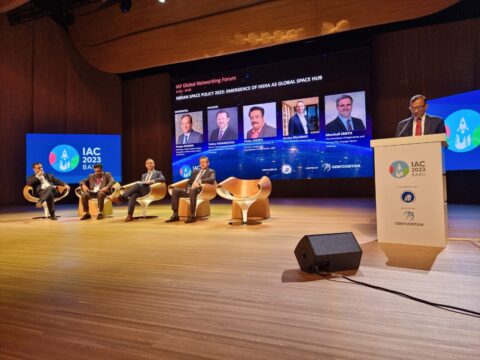India’s space sector is turning out to be a healthy collaboration between government agencies and the private sector. The space startup space is sprucing up even as potential foreign investment is creating excitement.
In October, IN-SPACe (Indian National Space Promotion and Authorization Centre), an autonomous nodal agency under Department of Space, Government of India, deliberated with global partners in the space sector on the potential of Indian Space Policy to catapult India’s capabilities as a friendly space-faring nation.

The panel discussion deliberated on the essence of the Indian Space Policy that seeks to institutionalize the private sector participation in the space sector with the Indian Space Research Organization focusing on the research and development of advanced space technologies and IN-SPACe focusing on the development of space ecosystem in the country.
The Indian Space Policy has significantly broadened India’s opportunity for further enhancing its stake in the global space economy
Dr. Pawan Goenka, Chairman, IN-SPACe
Dr. Pawan Goenka, Chairman, IN-SPACe said, “The Indian Space Policy has significantly broadened India’s opportunity for further enhancing its stake in the global space economy. At present, the 60-year-old space sector is becoming a sunrise sector in India with more than 200+ space startups contributing to growth of the commercial space sector in India. IN-SPACe has been striving to create a harmonized collaborative environment that will help position India as a significant player in the global commercial space sector.”
Space Tie Up
The space startup sector is indeed forging ahead. In October, one of the major centres of Indian Space Research Organization (ISRO), Space Applications Centre (SAC) tied up with Ahmedabad-based Nav Wireless Technologies Pvt Ltd (NavTech) to use light-based high-speed communication for satellite communication in space.
Read more: Global eyes on India’s SpaceTech startup ecosystem after Chandrayaan 3 success
Space agencies have already started using optical wireless technologies instead of Radio Frequency for space communication. SAC will use high speed secure quantum key communication using light from base station to satellite in space & terrestrial communication.
Through this technology, SAC will be able to do the quantum key distribution (QKD) & pointing acquisition and tracking (PAT) for satellite-to-satellite communications in the space. The technology is all set to be used in ISRO’s upcoming space exploration programs.
Very few space agencies in the world are currently using LiFi technology for secured communication between base stations and for satellite communications around the globe
Hardik Soni, co-founder and CTO of Nav Wireless Technologies Pvt Ltd.
Hardik Soni, co-founder and CTO of Nav Wireless Technologies Pvt Ltd. Said, “Very few space agencies in the world are currently using LiFi technology for secured communication between base stations and for satellite communications around the globe.”
Li/Fi, also known as Light Fidelity, utilizes the transmission of data through a light beam spectrum in both indoor and outdoor environments. This technology enables ultra-fast data connections and proves especially valuable in urban areas with congested radio spectra, as well as in rural regions where fiber optic cables or networks are not available.
Govt. Tie Ups
In October, Optimized Electrotech Pvt Ltd (OEPL), an imaging surveillance technology company, announced the successful technology transfer of the Optical Imaging System (OIS) from NewSpace India Limited (NSIL) which is developed by the ISRO.
The OIS developed by ISRO represents a significant leap in technology. It empowers long-distance surveillance across visible and near-infrared spectra of the electromagnetic spectrum. Notably, it operates seamlessly during twilight and mid-day lighting conditions, employing a single sensor and a consistent setup. This revolutionary advancement holds immense potential, particularly in coastal and desert areas and various applications where precision surveillance is critical.
With the surveillance systems market in India poised to reach $2.5 billion and annual growth rates of 25-30%, this collaboration is a game-changer. OIS promises to revolutionise security and surveillance in demanding environments, aligning perfectly with the current market demand
Sandeep Shah, Co-Founder and Managing Director at Optimized Electrotech
Sandeep Shah, Co-Founder and Managing Director at Optimized Electrotech, said, “With the surveillance systems market in India poised to reach $2.5 billion and annual growth rates of 25-30%, this collaboration is a game-changer. OIS promises to revolutionise security and surveillance in demanding environments, aligning perfectly with the current market demand.”
Also, in August, space education company, SPACE India tied up with the ISRO as an official Space Tutor. The Registered Space Tutor program is a unique initiative created by ISRO in 2022, whose aim is to engage with various individuals and organisations across India that promote space education. SPACE India will enhance the subject matter that includes application of satellites, space missions, rockets, stars, etc, with more in-hand insights from ISRO’s research projects and missions.
Foreign Investment in Indian Space
In September, Minister of Large & Medium Industries & Infrastructure Development, Government of Karnataka, M.B. Patil invited US-based aerospace company RTX Corporation (formerly Raytheon Technologies), and integrated satellite and terrestrial network provider Intelsat, to invest in Karnataka.
The US$67.1 billion revenue-generating RTX Corporation has a presence in India for more than 25 years with an R&D facility, customer training centre, along with operations and an engineering unit in Bengaluru.
Addressing the industry leaders in the US, Patil said, “We are going to meet some of the prestigious companies here in the United States, to understand their requirements and invite them to Karnataka for expansion or collaboration.”
Read more: India makes history: Chandrayaan-3 touches down on the Moon’s south pole successfully
Intelsat, which has a long history of collaboration with ISRO, discussed the possibilities of expanding the operational scope of its Indian arm and satellite-sourcing opportunities from Indian space startups. The company also discussed exploring collaboration opportunities in software solutions and the role of AI/ML in satellite communications. Intelsat also discussed the possibility of establishing a global capability centre as part of its long-term planning in India.
Last month, India’s Chandrayaan-3 had bad news when a month after the moon lander made history, the traveller and its sidekick lunar rover died without any hope of revival. Harsh environmental weather and extreme cold temperatures are the culprit according to reports. Collaborations between the government and private sector could prevent such failures.












